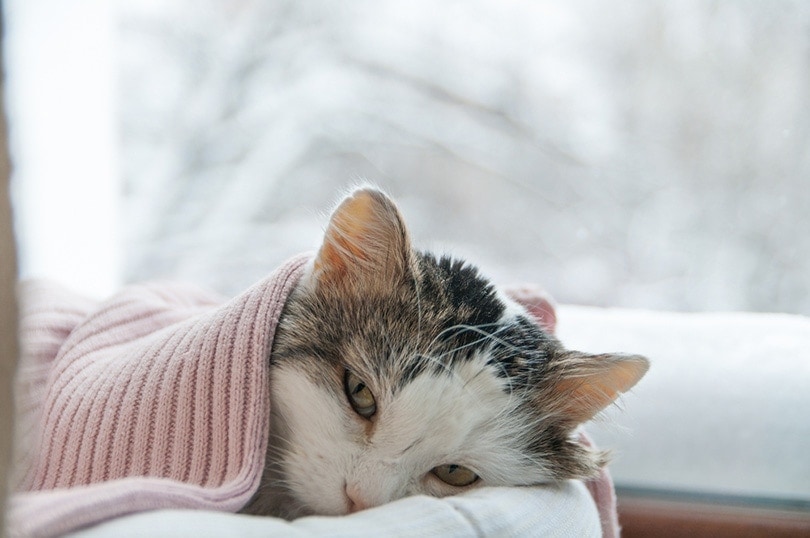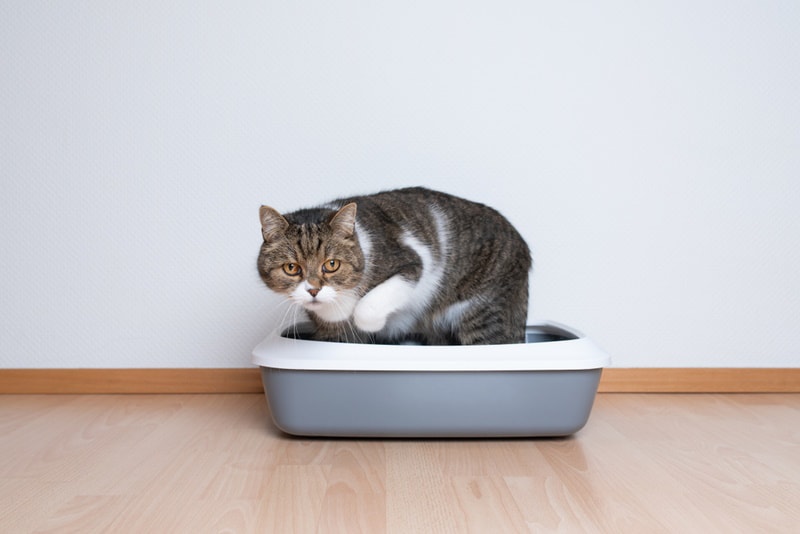
Click to Skip Ahead
It is always tricky when a cat swallows a rubber band. There is a chance that nothing could happen; they just pass the rubber band in their stool. However, they could end up with severe intestinal blockage and complications that could be deadly.
The first thing to do is to make sure they can’t swallow any more rubber bands. Then call your vet and follow their advice and monitor them.
The Problem With Rubber Bands
What could happen if your cat swallows a rubber band? Small rubber bands are hopefully less of a concern than larger ones. But if your cat has swallowed a particularly large rubber band, you might need to be on extra alert.

What to Do Right Away
It is always a good idea to call your vet to check in right away. Depending on the situation, the vet’s advice might change. They might want to try and find the rubber band and check that it is not stuck in the throat. They also might try to retrieve it. It depends on the situation.
But they will likely advise you to monitor and watch your cat carefully. If your cat passes the rubber band without a problem, problem solved! And, sometimes, bringing a cat in for a physical exam before anything has happened stresses the cat out more which can cause them not to poop normally—the opposite of what we want to encourage.
Watching for changes in your cat gives them time to resolve the issue without the extra stress of going to the vet. But it also means if something goes wrong, you will know right away and will be able to act quickly.
Inspect the Mouth and Throat
If you can safely do it, it is probably a good idea to check and see if the rubber band is stuck in their mouth. A cat’s tongue is spiked with prongs that point backward so that stringy objects (like rubber bands) can get stuck and can’t be spit back out.
If the rubber band gets stuck in the mouth, around the tongue, it is very difficult to eat, drink, and possibly even breathe. It could even dangle off the tongue down the throat—even more uncomfortable.
You might not be able to see it if the rubber band is stuck on the tongue. Cats are not always amenable to saying ‘Ahhh’ and opening wide for you to get a good look. So, if you can’t see it but your cat is doing any of the above, bring it to the vet so they can help.

Don’t Pull It Out
If you can see the rubber band in your cat’s throat, do not yank it out! Pulling it out could cause severe tissue damage in the throat or even tear the tongue. Tongues and throats bleed a lot, and it could turn into an absolute mess.
And especially if it is dangling down the throat, pulling it up and out could tear it if it gets tangled. Imagine pulling a belt through your pant loops; it doesn’t always go smoothly without everything bunching up into a big knot.
However, if your cat is choking and struggling to breathe, you might just have to go for it. In this type of emergency. But be gentle and try not to rip your cat’s tongue out. Use your fingers to tease the rubber band out and hold the mouth wide open with your non-dominant hand.
Also, don’t get bitten. If your cat is not actively choking, bringing them to the vet, where they can safely and gently remove the rubber band, is definitely the best option.
Other Signs to Look For
1. Stomach Problems
The next place a rubber band could get caught is in the stomach. If it gets stuck in the stomach and causes obstruction, your cat is likely to start vomiting, not eating, and showing other signs of foreign body obstruction.
A rubber band stuck in the stomach forms an obstruction so that food and water cannot pass. Or sometimes, it causes a partial obstruction, so only some of the food goes sliding past. This is uncomfortable and can escalate quickly into an emergency, especially if they constantly vomit.

2. Intestine Problems
Next, the rubber band could get stuck in the intestines. It could also just form a simple blockage in the intestine, like a clogged sink drain. However, it could get more complicated.
A rubber band, particularly one that has torn and is now a rubber string, can snake along the intestine, and then when the intestine naturally moves and contracts, the rubber band tangles the intestine in and over itself. It can bunch up, just like pushing your sleeve up your arm, or it can twist around, creating a twist or a knot, like a kinked hose.
These blockages are very dangerous because the walls of the intestine are overly stretched, and the blood supply is cut off. The walls of the intestine can start to die off. And the contents of the intestines can start to leak out of the weakened walls—just like a kinked hose can leak when it’s kinked but not when it’s straight.
If this happens, the cat will need immediate surgery to fix the problem. The longer it waits, the worse everything gets. So carefully monitor for the following signs and bring them to the vet if you notice any.
3. Colon Problems
Once a rubber band reaches the colon, it only has to pass through it to be free and clear.
It could still cause an obstruction, though. And it could also cause constipation, even if the cat does eventually pass it. Monitoring for signs of constipation will be your main task, and watching those poops for signs of the rubber band.
If you see any of the signs listed below, you guessed it, bring your cat to the vet. If the rubber band comes out partially (hanging out of the anus), do not forcefully pull it out. If it is stuck in the colon and you pull it, you could tear the colon as you stretch the band. Again, imagine pulling that stuck belt through pant loops.

Frequently Asked Questions (FAQ)
Should I feed them anything to encourage the rubber band to move along?
My first advice would be to NOT change their diet. Just keep them on their normal diet. Too many cats have food sensitivities, allergies, or just plain and simple delicate stomachs that get upset when their diet changes suddenly, which creates its own problem, let alone make the rubber band situation worse.
Sometimes a vet will advise feeding a laxative or extra fiber to move it along. But I wouldn’t do this without veterinary advice and consideration of your cat’s sensitivities.
You don’t want to trigger gastroenteritis—inflammation of the stomach and intestines—as well as have a rubber band floating through it.
What should I do if it’s stuck in the stomach?
This is where your monitoring skills come into play. If your cat has swallowed a rubber band and they start vomiting or showing other signs, bring them to the vet right away. The sooner, the better.
If it is stuck in the stomach, the vet may be able to retrieve it with an endoscope. Or they may elect surgical removal. They might also try inducing vomiting. There are a couple of treatment options depending on the situation.
Will the body digest a rubber band?
No, the body will not digest or dissolve the rubber band. It will remain intact throughout the digestive tract until it is pooped out. Or surgically removed (hopefully not).
The teeth might tear it so that it turns into a rubber string, but it is likely to be largely unaffected by its journey through the stomach, intestines, and colon.
Final Thoughts
If your cat swallows a rubber band, it can be a frustrating and scary situation. If the rubber band is small enough, it might just pass through your cat, undigested, and without causing any harm. Carefully examine your cat’s poop to know when it has passed.
But if it is too big, forms a tangled string, or otherwise gets stuck, the situation can easily turn into a life-threatening emergency. Practice your monitoring skills and get to know what is normal or abnormal for your cat.
Cats can hide their sickness for a long time. So, the better you are at watching them, their eating habits, their pooping habits, and their overall comfort, the more likely you are to catch a problem as early as possible. Monitoring often is a group effort involving your family and your vet. Work together for your cat’s health, and never allow your cat to play with rubber bands without watching them like a hawk.
See Also:
- My Cat Ate String, What Should I Do? (Vet Answer)
- My Cat Ate a Hair Tie: What Should I Do? (Vet Answer)
Featured Image Credit: Pixabay







